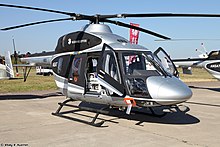Kazan Ansat
| Kazan Ansat | |
|---|---|

|
|
| Type: | Light multipurpose helicopter |
| Design country: | |
| Manufacturer: | |
| First flight: |
August 17, 1999 |
The Kazan Ansat ( Russian Казанский Ансат ) is a Russian helicopter made by Kazan Helicopters . It is designed with two engines, has a four-blade main and two-blade tail rotor and a skid chassis. The name Ansat comes from the Tatar language and means "simple" or "uncomplicated".
The hull is made of aluminum. Parts that do not belong to the load-bearing structure, such as doors and covers, are made of composite material. The rotor works without bearings. The rotor blades are connected to the rotor hub via a torsion element. The rotor blades consist of a spar made of composite material, which is provided with a counterweight in the front area and connects to a covered sandwich honeycomb core structure in the rear area . The helicopter is available in both a version with skids and a landing gear.
The Ansat is controlled with a quadruple redundant fly-by-wire system with electrical sensors and hydraulic actuators.
Development began in 1993 because the Mil Mi-2 that had previously been manufactured was no longer competitive. In 1997 a 1: 1 scale dummy was completed. In 1998 the first prototype was completed and subjected to ground tests. Various changes had to be made, which were incorporated into the second prototype, which made its maiden flight on August 17, 1999 . The flight program was completed by 2001.
The third prototype was proposed as a military school helicopter. The name of the machine with double control is Ansat-U. He won the tender in 2001. On April 1, 2004, the system tests could begin with the correspondingly modified fifth prototype.
The knowledge gained and a more powerful engine (PW207K) led to further modifications, such as a changed power transmission, a new tail rotor and some changes to the cabin. The third prototype first flew on December 27, 2001. It was tested again with over 300 flights by 2004. At the same time, a one-meter version, the Ansat-3, was developed, which has a longer cabin for up to 14 passengers. Further changes are a five-blade main and a four-blade tail rotor and a fixed nose landing gear. This variant was first presented at the MAKS 2003. Some system components are also used in the Kazan Ansat-2RZ .
So far, seven Ansat-1s have been exported to South Korea. The Russian Air Force has ordered around 40 of the Ansat-U school version, of which around ten had been delivered by 2012.
Technical specifications
| Parameter | Data |
|---|---|
| crew | 1 |
| Passengers | up to 9 |
| Length over all | 13,543 m |
| height | 3.56 m |
| Rotor diameter | 11.5 m |
| Cabin length | 4.60 m |
| Cabin width | 1.68 m |
| Cabin height | 1.3 m |
| Max. Takeoff mass | 3300 kg |
| Engine | 2 × Pratt & Whitney Canada PW207 |
| Starting power | 463 kW each |
| Continuous output | 413 kW each |
| Top speed | 285 km / h |
| Cruising speed | 250 km / h |
| Service ceiling | 5700 m |
| Max. Floating height | 3300 m |
| Range | 635 km |
Web links
Individual evidence
- ^ Robert Kluge: Mi-17 & Co - helicopters from Kazan. In: Flieger Revue No. 12/2012, pp. 18/19

